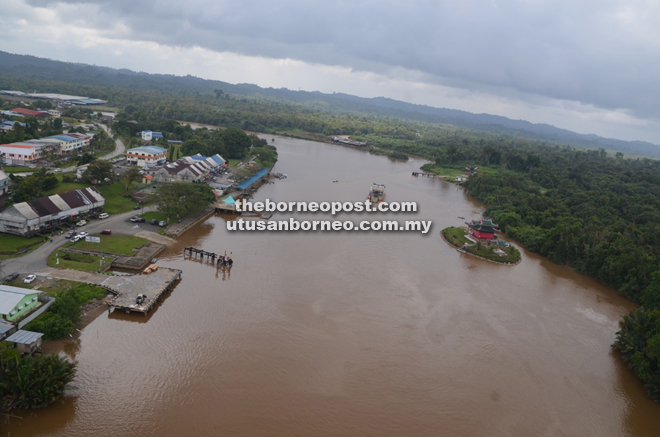
An aerial view of Sebauh town.
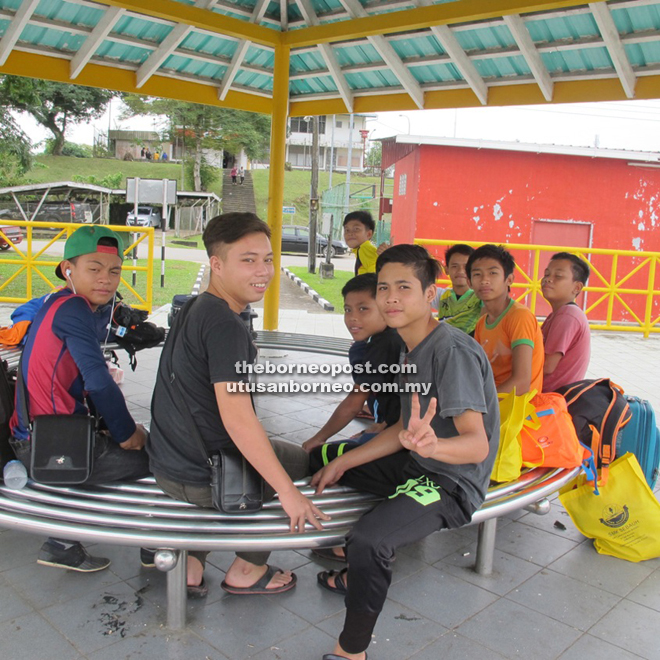
Eight SMK Sebauh students who came to Sebauh town at about 7am yesterday by an express boat from Binyo. They had to linger at the express terminal for hours because the school would fetch them only at 11am.
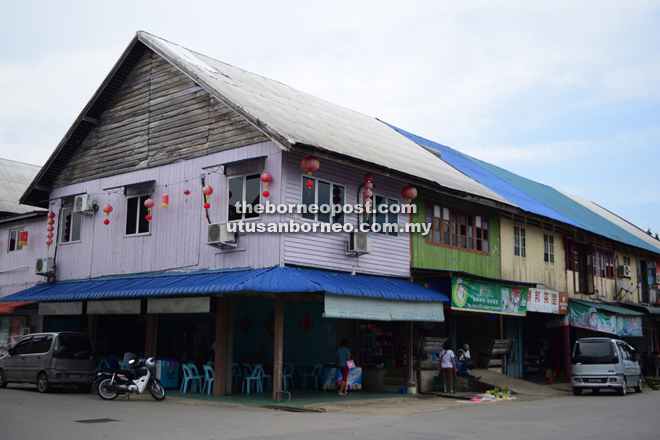
Unlike other towns, old shophouses in Sebauh still stand tall, and business is good.
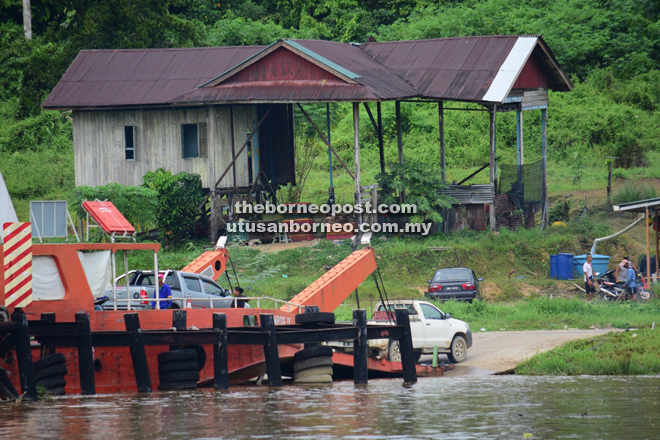
Ferry service is still very much in use between Sebauh town and Sungai Sebauh, which is on the other side of the river.
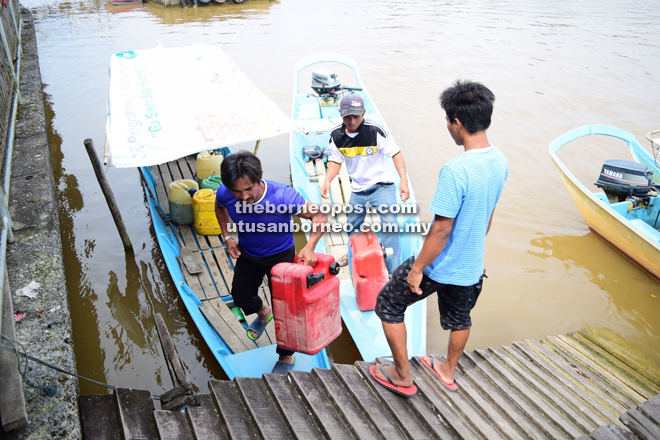
Everyone in Sebauh knows how to handle speedboats.
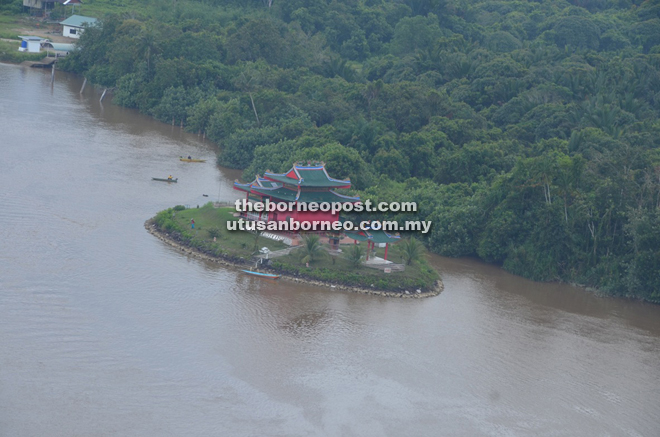
An aerial view of the floating temple in Sebauh —Natok Kon.
MIRI: Jakar—about an hour’s drive from Sibu—is famous for its prawn noodles, but so is Bintulu.
At a coffeeshop by the waterfront, prawn noodle is a must-have among locals and travellers alike. And talking about food, `fried chicken feet’ sold at a coffeeshop adjacent to the one selling prawn noodle is surreal.
No doubt food is good in Bintulu, but so is the price. Coming from a town (Sibu) known for its reasonably priced food, having to pay more in Bintulu for the same delight made me appreciate home more.
After a tough day at Tubau on Sunday, a settlement of about two-hour drive from Bintulu town, BAT6 headed to Miri yesterday using our trusty ‘Batmobile’—Isuzu MU-X.
Our initial plan was to zero in onto Niah, but a whole-day trip with Sebauh Division officer Desmond Jerukan in Tubau changed our mind.
“You must go to Sebauh. There is a floating temple in Sebauh, and it is the only such temple in Sarawak,” he told us on Sunday.
Floating temple? Hmm . . . this sounds like a job for ‘BATmen’.
So, yesterday, after a meeting with Bintulu MP Datuk Seri Tiong King Sing, we detoured to Sebauh. Our initial plan was to snap a few pictures and then leave.
However, once we reached the town, we fell in love with it.
Lying about 48 km from Bintulu town and nestled along the banks of Kemena River, Sebauh does not have that shabby, dusty look of many rural towns. It was clean and pleasant.
In fact, it is a marriage of the old and new. The old structures are typical Chinese shops fronting the waterfront while the new ones are mostly government buildings.
Desmond said Sebauh used to be a sub-District under Bintulu Division, but it was elevated to a District on Aug 1 last year.
“Sebauh now stands equal to Bintulu District and Tatau District. It comprises of Sebauh proper and rural areas like Pandan, Maskat, Labang, Binyo and Tubau.”
Apart from the floating temple, he said other special features in Sebauh included the Heritage Site Totem Pole in Pandan and the ferry, which plies between Sebauh and Sungai Sebauh.
As the town is small, we have no difficulty looking for the temple, situated on Kemena River. From Sebauh town, one has to take a boat to get to the temple, and per crossing on a speedboat costs RM2.
Contrary to being known as a ‘floating’ temple, Natok Kon Sebauh actually sits on an island or a ship-like rock on Kemena River. From across the river, and with lush green forest for a backdrop, it looked majestic, with its bright green and red paints and the dragon carvings on the roof.
Its interior, however, is relatively simple.
Apart from the three main deities on the altar, there was not much else that catches the eye inside the temple.
However, don’t be fooled by its simple interior. The deities are believed to wield great powers in helping those in need. Every year, two big celebrations will be held, and worshippers from Bintulu and Sebauh will congregate at the town to pay their respects to the deities.
There are many legends on how the temple came into being. The Chinese have their own versions while the Ibans have theirs.
Regardless, what is clear is that the three were Malays before they became deities and are worshipped by the Chinese. The three are Datuk Tuanku, Datuk Haji and Datuk Su.
Among the Chinese community, there are several versions on how the temple came about.
Chang Ming Chow, 60, who was born and raised here, said one legend involved three fishermen on a boat looking for wild ferns across the river. While they were on their boat, suddenly a storm struck, their boat flipped, and all three disappeared. A huge rock that resembles a boat then appeared at the spot where the boat sank.
After that, whenever the moon is high, there will be three figures in white robes appearing on the island. They would wave at those spotting them.
“From then onwards, whoever come for 4-digit numbers will get lucky. It is rumoured that the amount of money won from 4-digit has reached RM2 million,” said Chang.
“The temple has been around for more than a century. It used to be a wooden one, but over the years, people started chipping in money till what it is today.” Chang, who is also SUPP Sebauh branch secretary, said it was labelled a floating temple because initially it was on Sebauh River. Over the years, it ‘floated’ down to Kemena River, and has not moved since.
Another legend also involved three Malay fishermen: Tuanku Silai, Haji Salleh and Mohammad Su. They were fishing at Kuala Sebauh a month before Chinese New Year.
While having a meal on their boat, two fishes from the river suddenly jumped out of the water and landed on Haji Salleh’s plate, and his two friends could not help laughing at him.
However, while they were still in stitches, a lizard from the roof of the boat they were in dropped onto Haji Salleh’s plate. That made the other two laughed even louder.
Haji Salleh asked them to stop, but they continued laughing until the boat sank, and efforts to look for their bodies were futile. Seven days later, Haji Salleh’s body was found at the present site, but the bodies of Tuanku Silai and Mohammad Su were never found.
They were believed to have turned into river deities.
Half a year after the incident, an island appeared at the site where their boat sank. After that, on every moonlit night, three men in white robes could be seen on the island. They are believed to be powerful deities who can help the people fulfil their wishes.
“Initially, many people who came here to worship them brought along pork. On those occasions, there would be soil erosion around the island, which shrunk the island.
“Then the people realised they were Muslim deities and should not be worshipped with pork. From then onwards, it is forbidden to bring pork across the river to the island.”
Penghulu Michael Lanyau, 71, has an even more interesting version to tell.
He related that according to folklore, there were three Malay sailors on a boat en route from Kuala Bintulu to Sebauh. They sailed for three days and anchored at Kuala Sebauh.
One day, the cook onboard made sago porridge for the trio, but instead of eating it, they played with the porridge by stretching and stirring it on each other’s heads. They laughed while making fun of each other with the food.
Their foolishness apparently angered the Almighty. Strong winds started blowing, the sky turned dark, and it started to rain stones. The stones hit everything onboard, including the three sailors, and they turned into stones.
“While they were being turned into stones, noises could still be heard from the boat. The noises only stopped when they were completely turned into stones.
“As the boat was at the mouth of the river, it obstructed other boats from entering Sebauh. An old but powerful shaman then came and placed charms on the stone boat. He managed to push the boat from Kuala Sebauh to the present site,” said Michael.
He added that a long time ago, the shape of the island really looked like a ship, and it was big and tall. But over the years, erosion took its toll.
“But no matter how serious Sebauh is flooded, flood water will not reach the temple. That is the magical part of it.”
Sitting at a coffeeshop and looking at Nato Kon Temple from across the river while listening to the legend related by an elderly Iban was a rare and wonderful experience.
And because of that experience, Sebauh will always be a special place for us.
Our advice to travellers is to make time for Sebauh, sit at the coffeeshop and strike up conversations with customers in the coffeeshop.
You are likely to meet people like retired teacher Geoffrey Nyandang. The friendly town folk will tell you stories of Natok Kon. There are so many versions you won’t be bored!
From Sebauh, we set off to Niah. Niah, which used to be well-known for the Niah Caves and bird’s nest is now a major oil palm plantation area.
But despite the fact that palm oil is bringing lots of money for the people, the town seems to be gloomy and dusty.
But the Niah Caves, far afar, remain majestic.
